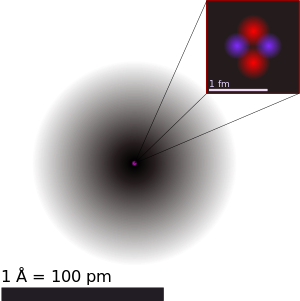
Back Helium-4 Afrikaans هيليوم-4 Arabic Heli 4 Catalan Helium-4 Czech Helio-4 Spanish Helio 4 Basque هلیوم-۴ Persian Hélium 4 French הליום-4 HE हिलियम-४ Hindi
This article needs additional citations for verification. (December 2023) |
| General | |
|---|---|
| Symbol | 4He |
| Names | helium-4, 4He, He-4 |
| Protons (Z) | 2 |
| Neutrons (N) | 2 |
| Nuclide data | |
| Natural abundance | 99.999863% |
| Half-life (t1/2) | stable |
| Isotope mass | 4.002603254 Da |
| Spin | 0 |
| Binding energy | 28295.7 keV |
| Isotopes of helium Complete table of nuclides | |

Helium-4 (4
He
) is a stable isotope of the element helium. It is by far the more abundant of the two naturally occurring isotopes of helium, making up about 99.99986% of the helium on Earth. Its nucleus is identical to an alpha particle, and consists of two protons and two neutrons.
Alpha decay of heavy elements in the Earth's crust is the source of most naturally occurring helium-4 on Earth, produced after the planet cooled and solidified. While it is also produced by nuclear fusion in stars, most helium-4 in the Sun and in the universe is thought to have been produced by the Big Bang, and is referred to as "primordial helium". However, primordial helium-4 is largely absent from the Earth, having escaped during the high-temperature phase of Earth's formation.
Helium-4 makes up about one quarter of the ordinary matter in the universe by mass, with almost all of the rest being hydrogen.
When liquid helium-4 is cooled to below 2.17 K (−270.98 °C), it becomes a superfluid, with properties that are very unlike those of an ordinary liquid. For example, if superfluid helium-4 is kept in an open vessel, a thin film will climb up the sides of the vessel and overflow. In this state and situation, it is called a "Rollin film". This strange behavior is a result of the Clausius–Clapeyron relation and cannot be explained by the current model of classical mechanics, nor by nuclear or electrical models — it can only be understood as a quantum-mechanical phenomenon. The total spin of the helium-4 nucleus is an integer (zero), and therefore it is a boson (as are neutral atoms of helium-4). The superfluid behavior is now understood to be a manifestation of Bose–Einstein condensation, which occurs only with collections of bosons.
It is theorized that at 0.2 K and 50 atm, solid helium-4 may be a superglass (an amorphous solid exhibiting superfluidity).[1][2][3]
Helium-4 also exists on the Moon and — as on Earth — it is the most abundant helium isotope.[4][5][6]
- ^ Giulio Biroli; Claudio Chamon; Francesco Zamponi (2008). "Theory of the superglass phase". Physical Review B. 78 (22): 19. arXiv:0807.2458. Bibcode:2008PhRvB..78v4306B. doi:10.1103/PhysRevB.78.224306. S2CID 3222218.
- ^ "Press release: Supersolid or superglass? Cornell researchers study a strange state of matter in helium - Cornell Chronicle".
- ^ Yu, Xiaoquan; Mueller, Markus (2012). "Mean field theory of superglasses". Physical Review B. 85 (10): 104205. arXiv:1111.5956. Bibcode:2012PhRvB..85j4205Y. doi:10.1103/PhysRevB.85.104205. S2CID 119261743.
- ^ "cold cathode gauges: Topics by Science.gov". www.science.gov.
- ^ "Final Report Cold Cathode Gauge Experiment" (PDF). ntrs.nasa.gov.
- ^ Cook, Melvin A. (1957). "Where is the Earth's Radiogenic Helium?". Nature. 179 (4552): 213. Bibcode:1957Natur.179..213C. doi:10.1038/179213a0. S2CID 4297697.
© MMXXIII Rich X Search. We shall prevail. All rights reserved. Rich X Search